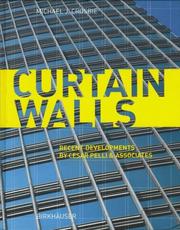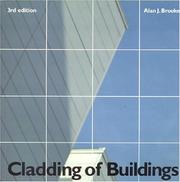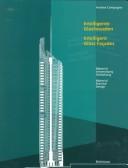| Listing 1 - 7 of 7 |
Sort by
|
Periodical
Abstract | Keywords | Export | Availability | Bookmark
 Loading...
Loading...Choose an application
- Reference Manager
- EndNote
- RefWorks (Direct export to RefWorks)
Roofing --- Insulation (Heat) --- Periodicals. [from old catalog] --- Siding (Building materials) --- Insulating materials --- Insulating materials. --- Roofing. --- Roofing materials --- Cladding (Building) --- Claddings (Building) --- Building materials --- Exterior walls

ISBN: 3764376546 3764370831 9783764370831 Year: 2005 Publisher: Basel, Switzerland : Birkhäuser - Publishers for Architecture,
Abstract | Keywords | Export | Availability | Bookmark
 Loading...
Loading...Choose an application
- Reference Manager
- EndNote
- RefWorks (Direct export to RefWorks)
Die Vorhangfassade - eine nichttragende Wand, die dem Gerüst eines Skelettbaus als Verkleidung vorgehängt wird - ist aus dem Vokabular der modernen Architektur nicht wegzudenken. Die Entwicklung der Elastomere hat das Traggerüst stark reduziert und die Voraussetzung für rein gläserne Hüllen geschaffen. In diesem Buch werden etwa zwanzig beispielhafte Fassadenlösungen des Büros Cesar Pelli & Associates dokumentiert. Nach den verschiedenen Fassadenmaterialien - Glas, Metall, Stein - geordnet, werden die jeweiligen Konstruktionsdetails ausführlich und mit vielen Zeichnungen dargestellt. Beleuchtet wird auch der Entwicklungsprozess der jeweiligen Fassadenlösung, die meist sehr individualisiert ist in Entwurf ebenso wie in Fertigung. Zu den dokumentierten Bauten gehören der Nakanoshima Mitsui Tower in Osaka, das Cheung Kong Center in Hongkong, die Bank Boston in Buenos Aires, der Mori Tower in Tokio, Heron Quay 3 in London oder das Gebäude 731 Lexington Avenue in New York.Michael J. Crosbie ist Architekt und hat zahlreiche Bücher über Architektur geschrieben. Früher Redakteur der Architekturzeitschrift Progressive Architecture, schreibt er heute regelmäßig für Zeitschriften wie Domus, Architectural Record und Landscape Architecture.
Curtain walls. --- Pelli, Cesar --- Themes, motives. --- Cesar Pelli and Associates. --- Cladding (Building) --- Claddings (Building) --- Enclosure walls --- Window walls --- Exterior walls --- Pelli and Associates --- Cesar Pelli & Associates --- 692.2 --- 692 --- 691.2 --- 691.4 --- 691.6 --- 691.7 --- 691 --- Gevels --- Buitenmuren --- Vliesgevels --- Gordijngevels --- Constructiedelen --- Natuursteen --- Leisteen --- Tegels --- Glas --- Metaal --- Bouwmaterialen (architectuur)

ISBN: 0419221700 Year: 1998 Publisher: London Spon
Abstract | Keywords | Export | Availability | Bookmark
 Loading...
Loading...Choose an application
- Reference Manager
- EndNote
- RefWorks (Direct export to RefWorks)
Building materials. Building technology --- Architecture --- Curtain walls. --- 692.23 --- 692.23 Exterior, external walls. Enclosing walls above ground generally. Walls in elevation. Façades --- Exterior, external walls. Enclosing walls above ground generally. Walls in elevation. Façades --- Curtain walls --- Cladding (Building) --- Claddings (Building) --- Enclosure walls --- Window walls --- Exterior walls
Book
ISBN: 9783035611458 3035611459 9783035609493 3035609497 9783035611342 3035611343 3035609489 9783035609486 Year: 2018 Publisher: Basel
Abstract | Keywords | Export | Availability | Bookmark
 Loading...
Loading...Choose an application
- Reference Manager
- EndNote
- RefWorks (Direct export to RefWorks)
Die Fassade ist die Schnittstelle des Gebäudes mit seiner Umwelt. Dort treffen bauphysikalische Parameter wie Wärme, Feuchte, Schall und Licht auf das Haus und wirken auf es ein. Alle diese Einflüsse bedürfen der Regulierung durch die Gebäudehülle, um Behaglichkeit für den Nutzer und Funktionstüchtigkeit der Architektur zu gewährleisten. Diese Einführung erläutert die wichtigsten Phänomene, um dann den Bezug zur Baupraxis herzustellen: Welche Materialien reagieren in welcher Weise auf diese Faktoren? Wie gehen Fassadensystemen mit Wärme, Feuchte, Schall und Licht um? Das praxisorientierte Buch, entstanden aus der Zusammenarbeit eines Architekten und eines Bauingenieurs, beschreibt die wichtigsten Fassadenmaterialien und -konstruktionen im Hinblick auf ihre bauphysikalische Performance. The facade is the building's interface with its environment. It is here that building physics parameters such as heat, humidity, sound and light interact with the building. All these influences need to be controlled by the building envelope in order to ensure the comfort of the user and the functional performance of the architecture. This introduction explains the most important phenomena and then relates them to design and building practice - which materials react in which way to these factors? How do facade systems deal with heat, humidity, sound and light? This practice-oriented book, which is the result of cooperation between an architect and a structural engineer, describes the most important facade materials and constructions under the aspect of their building physics performance.
692 --- 692 Structural parts and elements of buildings --- Structural parts and elements of buildings --- Siding (Building materials) --- 699.8 --- 692.2 --- Gevelconstructies ; buitenmuren --- Beschermende maatregelen aan gebouwen --- Constructie-elementen van gebouwen ; wanden, muren --- Cladding (Building) --- Claddings (Building) --- Building materials --- Exterior walls

ISBN: 376435996X 081765996X 9783764359966 Year: 1999 Publisher: Basel Birkhäuser
Abstract | Keywords | Export | Availability | Bookmark
 Loading...
Loading...Choose an application
- Reference Manager
- EndNote
- RefWorks (Direct export to RefWorks)
Building materials. Building technology --- glassworking --- Architecture --- façades --- curtain walls [nonbearing walls] --- Glass --- Architecture de verre --- Vitrage --- Verre --- Façade --- Curtain walls --- Glass construction --- #KVIV:BB --- 691.6 --- Glass architecture --- Glass as structural material --- Glass in architecture --- Building --- Cladding (Building) --- Claddings (Building) --- Enclosure walls --- Window walls --- Exterior walls --- Glass. Window glass. Plate glass. Enamel etc. --- 691.6 Glass. Window glass. Plate glass. Enamel etc. --- façades and façade components --- Glass. Window glass. Plate glass. Enamel etc
Book
ISBN: 907246978X Year: 1996 Publisher: Rotterdam : NAi, cop,
Abstract | Keywords | Export | Availability | Bookmark
 Loading...
Loading...Choose an application
- Reference Manager
- EndNote
- RefWorks (Direct export to RefWorks)
Architecture --- Façades --- Construction en verre --- Designs et plans --- Nederlands architectuurinstituut --- Constructions --- Design et plans --- Rotterdam (Pays-Bas) --- 691.6 --- 691 --- 692.2 --- 69 --- 69.01 --- Eekhout, Mick --- Coenen, Jo --- NAi --- Nederlands Architectuurinstituut --- Rotterdam --- Glas --- Bouwmaterialen (architectuur) --- Gevels --- Bouwtechniek --- Constructie --- façades and façade components --- post-1945 architecture and design styles and movements --- architectural glass --- architecture [discipline] --- Netherlands Architecture Institute [Rotterdam] --- Curtain walls --- Glass construction --- Glass architecture --- Glass as structural material --- Glass in architecture --- Building --- Cladding (Building) --- Claddings (Building) --- Enclosure walls --- Window walls --- Exterior walls --- Façades. --- Construction en verre. --- Designs et plans. --- Constructions. --- Façades
Book
ISBN: 9400768478 9401782601 9400768486 Year: 2013 Publisher: Dordrecht ; New York : Springer,
Abstract | Keywords | Export | Availability | Bookmark
 Loading...
Loading...Choose an application
- Reference Manager
- EndNote
- RefWorks (Direct export to RefWorks)
This volume presents new methodologies for the design of dimension stone based on the concepts of structural design while preserving the excellence of stonemasonry practice in façade engineering. Straightforward formulae are provided for computing action on cladding, with special emphasis on the effect of seismic forces, including an extensive general methodology applied to non-structural elements. Based on the Load and Resistance Factor Design Format (LRDF), minimum slab thickness formulae are presented that take into consideration stress concentrations analysis based on the Finite Element Method (FEM) for the most commonly used modern anchorage systems. Calculation examples allow designers to solve several anchorage engineering problems in a detailed and objective manner, underlining the key parameters. The design of the anchorage metal parts, either in stainless steel or aluminum, is also presented.
Curtain walls --- Stone veneers. --- Design and construction. --- Stone slab veneers --- Veneers, Stone --- Veneers, Stone slab --- Cladding (Building) --- Claddings (Building) --- Enclosure walls --- Window walls --- Engineering. --- Structural mechanics. --- Civil engineering. --- Structural materials. --- Civil Engineering. --- Structural Materials. --- Structural Mechanics. --- Masonry veneers --- Exterior walls --- Materials. --- Mechanics. --- Mechanics, Applied. --- Solid Mechanics. --- Applied mechanics --- Engineering, Mechanical --- Engineering mathematics --- Classical mechanics --- Newtonian mechanics --- Physics --- Dynamics --- Quantum theory --- Engineering --- Engineering materials --- Industrial materials --- Engineering design --- Manufacturing processes --- Public works --- Materials --- Architectural materials --- Architecture --- Building --- Building supplies --- Buildings --- Construction materials --- Structural materials --- Facades. --- Building stones. --- Structural design.
| Listing 1 - 7 of 7 |
Sort by
|

 Search
Search Feedback
Feedback About UniCat
About UniCat  Help
Help News
News